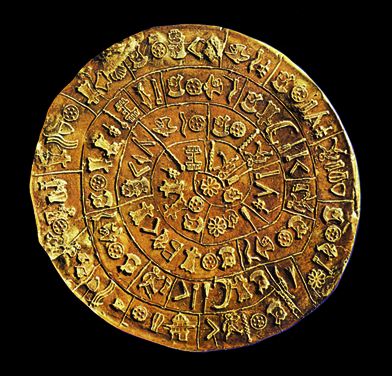On 3rd July 1908, the Italian archaeologist Luigi Pernier, working in the so-called ‘House 101’, northeast of the palace of Phaistos, found an object with symbols on both sides, next to a Linear A tablet. The object became known as the Phaistos Disc—and it remains as intriguing and mysterious now, over a hundred years later, as it was then. Physically it is round, hand-made, about 1.5cm thick and approx. 16.2cm in diameter, with an incised spiral decoration. The spiral is filled with little symbols, 241 or so of them (most of the motifs occurring more than once), stamped on the fresh clay. They represent the earliest evidence of the use of movable type. The clay is free from impurities and the object, unlike the tablets, was fired deliberately.

The excavator assumed it had fallen from the upper storey and that it was of Cretan manufacture. Not much progress has been made since then, though not for want of trying. Nothing else remotely similar has ever been found—and that is the main problem. Accusations of foul play were made as early as 1913. The villain of the piece was said to be Pernier who, jealous of his fellow archaeologist Halbherr’s success at Gortyn (also in Crete), where he found the famous Law Code, and of Evans’s discoveries at Knossos, deliberately planted a forged object with an invented script in order to raise the profile of his excavations. However, while it is true that Phaistos could not rival Knossos as to finds, at Aghia Triada nearby, also excavated by the Italians, the quality and quantity of material was truly amazing. Pernier and the Italian School had their hands full. He seems an unlikely accomplice in a forgery of this magnitude.
Interpretations of the object’s function and meaning are extremely diverse, ranging from an astronomical or astrological calendar to a hymn to victory, a nursery rhyme or a sacred text. Current thought assumes it is a piece of writing though the direction of it, from the centre to the periphery or the other way round, has yet to be established. The small number of characters, 45 in total, suggests it is a syllabic script and close to Linear A, which has not yet been deciphered. There has been no shortage of proposed translations, based on languages as diverse as Chinese, Dravidian, Georgian, Hittite, Luwian, Semitic, Slavic and Sumerian. Indeed it was this abundance that prompted the late John Chadwick, who decoded Linear B with Michael Ventris, to appeal to those producing their own solutions ‘not to send them to him’.
With appropriate testing, it would be possible to put this case to rest one way or another. Modern techniques such as thermoluminescence are not invasive and would ascertain the date of the firing, thereby deciding once and for all the question of authenticity, while the analysis of a minimal quantity of the clay could assist in determining provenance. So far the authorities involved have resisted all calls for such tests. But the case should not be allowed to linger.
Blue Guide Crete, which combs the island in loving detail, will be available in digital format later this month.






